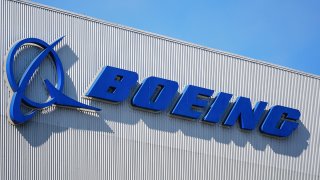- Huawei not only appears to represent Beijing’s answer to Nvidia – it is creating an entire AI ecosystem around its AI chips, providing data centers and software.
- The company’s recent AI success comes despite a crackdown from Washington that has seen it cut off from advance technologies from the West.
Stream San Diego News for free, 24/7, wherever you are with NBC 7.
Despite being beaten down by years of U.S. trade restrictions, China’s telecom giant Huawei has quietly emerged as one of the country’s fiercest competitors across the entire AI landscape.
Not only does the Shenzhen-based firm appear to represent Beijing’s answer to American AI chip darling Nvidia, but it has also been an early adopter of monetizing artificial intelligence models in industrial applications.
Get top local San Diego stories delivered to you every morning with our News Headlines newsletter.
“Huawei has been forced to shift and expand its core business focus over the past decade… due to a variety of external pressures on the company,” said Paul Triolo, partner and senior vice president for China at advisory firm DGA-Albright Stonebridge Group.
This expansion has seen the company get involved in everything from smart cars and operating systems to the technologies needed for the AI boom, such as advanced semiconductors, data centers, chips and large language models.
“No other technology company has been able to be competent in so many different sectors with high levels of complexity and barriers to entry,” Triolo said.
Money Report
Brexit made businesses abandon the UK. Trump’s hefty EU tariffs could bring them back
Singapore dollar exhibits safe-haven currency features. But it’s no yen or Swiss franc — yet
This year, Nvidia CEO Jensen Huang has become increasingly vocal in calling Huawei ”
one of the most formidable technology
companies in the world.” He has also warned that Huawei will replace Nvidia in China if Washington continues to restrict U.S. chip firms’ exports to the Asian country.
Nvidia surpassed $4 trillion in market capitalization last week to become the world’s most valuable company. Its cutting-edge processors and a related “CUDA” computing system
remain the industry standard
for training generative AI models and applications.
But that moat may be narrowing, as Huawei proves that it not only does it all, it does it well. While challenging American AI stalwarts like Nvidia is a tall order, the company’s history shows why it can’t be counted out.
Huawei, which now
employs
more than 208,000 people across over 170 markets, came from humble beginnings. Founded by ambitious entrepreneur Ren Zhengfei in 1987 out of an apartment in Shenzhen, the firm started as a small telephone switch distributor.
As it grew into a telecoms player, it gained traction by targeting less developed markets such as Africa, the Middle East, Russia and South America, before eventually expanding to places like Europe.
By 2019, Huawei would be well-positioned to capitalize on the
global 5G rollout
, becoming a leader in the market. Around this time, it had also blossomed into one of the world’s largest smartphone manufacturers and was even designing smartphone chips through its chip design subsidiary, HiSilicon.
But Huawei’s success also attracted increasing scrutiny from governments outside China, particularly the U.S., which has frequently accused Huawei’s technology of posing a national security threat. The
Chinese company
has
refuted such risks
.
Huawei’s business suffered a major setback in 2019 when it was placed on a U.S. trade blacklist, preventing American companies from doing business with it.
As the impact of the sanctions kicked in, Huawei’s consumer business – once the company’s
largest by revenue
– halved to about
$34 billion
in 2021 from the year before.
The company still managed a breakthrough on AI chips, and pressed ahead despite additional U.S. restrictions in 2020 that cut the company off from chipmaker Taiwan Semiconductor Manufacturing Co. A year earlier, Huawei
officially launched
its Ascend 910 AI processing chip as part of a strategy to build a “full-stack, all-scenario AI portfolio” and to become a provider of AI computing power.
But the U.S. targeting of Huawei also had the effect of turning the company into a martyr-like figure in China, building upon attention it received in 2018 when Meng Wanzhou, Huawei’s CFO and daughter of Ren, was
arrested in Canada
for alleged violations of Iran sanctions.
As the U.S.-China tech war continued to expand and broad advanced chip restrictions were placed on China, Huawei was an obvious choice to become a national champion in the race, with more impetus and state backing for its AI plans.
“The export controls have ironically pushed Huawei into the arms of the Chinese government in a way that CEO Ren Zhengfei always resisted,” Triolo said. In this way, the restrictions also became “the steroids” for Huawei’s AI hardware and software stack.
After another year of declining sales in the consumer segment, the unit started to turn around in 2023 with the release of a smartphone that
analysts said contained an advanced chip
made in China.
The 5G chip came as a shock to many in the U.S., who didn’t expect Huawei to reach that level of advancement so quickly without TSMC. Instead, Huawei was reportedly working with Chinese chipmaker SMIC, a company that has also been blacklisted by the U.S.
While semiconductor analysts said the scale that Huawei and SMIC could produce these chips was severely limited, Huawei nonetheless had proved it was back in the advanced chip game.
It was also around this time that reports began surfacing about Huawei’s new AI processor chip, the Ascend 910B, with the company looking to seize upon gaps left by export controls on Nvidia’s most advanced chips. Mass production of the next-generation 910C is
reportedly
already on the way.
To fill the void left by Nvidia, Huawei “has been making big strides in replicating the performance of high-end GPUs using combinations of lower chips,” said Jeffrey Towson, managing partner at TechMoat Consulting.
In April, Huawei unveiled its “AI CloudMatrix 384”, a system that links 384 Ascend 910C chips in a cluster within data centers.
Analysts
have said CloudMatrix is able to outperform Nvidia’s system, the GB200 NVL72, on some metrics.
Huawei isn’t just catching up, “it’s redefining how AI infrastructure works,”
Forrester analysts said
in a report last month about CloudMatrix.
Meanwhile, Huawei has also developed its own “CANN” software system that
acts as an alternative to Nvidia’s CUDA
.
“Winning the AI race isn’t just about faster chips. It also includes delivering the tools developers need to build and deploy large-scale models,” Forrester’s report said, though authors noted that Huawei’s products are still not integrated enough with other commonly used tools for developers to switch over quickly from Nvidia.
While Huawei’s goal to surpass Nvidia is seen as a key development in China and the U.S.’s race for AI, it’s important to note that chips represent just one building block of Huawei’s broader AI plans.
Huawei now has its hands throughout the artificial intelligence value chain, from chips to computing, to AI models and AI applications. These different AI business avenues also leverage other areas of the company’s vast technology empire.
In fact, the company’s “ICT Infrastructure” business — which includes 5.5G cellular network deployment and AI systems for industrial use — became the company’s largest revenue driver at 362 billion yuan in 2023.
The company has been
deploying
its Ascend AI chips and AI CloudMatrix 384 at its growing portfolio of AI data centers, which are operated by its cloud computing unit, Huawei Cloud, established in 2017 to compete with the likes of
Amazon
Web Services and
Oracle
.
These data centers, in turn, have provided the training capabilities and computing power used by Huawei’s suite of AI models under its Pangu series.
Unlike other general-purpose AI models like OpenAI’s GPT-4 or Google’s Gemini Ultra 1.0, Huawei’s Pangu model is designed to support more industry-specific
applications across
the medical, finance, government, industrial and automotive sectors. Pangu has already been applied in more than 20 industries over the last year, the company
said last month
.
Rolling out such AI applications often involves having Huawei tech staff working for months at the project site, even if it’s in a remote coal mine, Jack Chen, vice president of the marketing department for Huawei’s
oil, gas and mining business unit
, which provides digital and intelligent solutions to transform these industries, told CNBC.
That research enabled the company in May to
deploy more 100 electric-powered trucks
that can
autonomously transport dirt or coal
using the telecom company’s 5G network, AI and cloud computing services.
And it’s not limited to China. The technology can “be replicated on a large scale in Central Asia, Latin America, Africa, and the Asia-Pacific,” Chen said.
Huawei has also open-sourced the Pangu models, in a move it said would help it expand overseas and further its “Ascend ecosystem strategy,” which refers to its AI products built around its Ascend chips.
Speaking to CNBC’s “Squawk Box Asia” on Thursday, Patrick Moorhead of Moor Insights & Strategy said he expected Huawei to push Ascend in countries part of China’s Belt and Road Initiative — an investment and development project aimed at emerging markets.
Over a period of five to 10 years, the company could begin to build serious market share in these countries, in the same way it once did with its telecommunications business, he added.
Also on CNBC
-
Astronomer CEO Andy Byron resigns after viral Coldplay ‘kiss cam’ controversy
-
Nvidia CEO Jensen Huang sells an additional $12.94 million worth of shares
-
Peter Thiel-backed cryptocurrency exchange Bullish files to go public on NYSE







